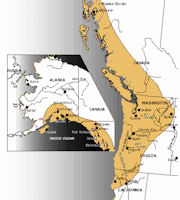Pacific Northwest - Environment
 The North Pacific Coast is defined primarily on the basis of its physical environment. Stated very simply, it is a region strongly subject to maritime influence and rugged terrain. Precipitation is high, and vegetation associated with heavy moisture is located near the coast but with marked variation over short distances because of the influence of surrounding mountains on the region's climate.
The North Pacific Coast is defined primarily on the basis of its physical environment. Stated very simply, it is a region strongly subject to maritime influence and rugged terrain. Precipitation is high, and vegetation associated with heavy moisture is located near the coast but with marked variation over short distances because of the influence of surrounding mountains on the region's climate.
The greatest average annual precipitation in the United States is found in the Pacific Northwest. Averages above 190 centimeters are common, and averages are double that amount on the western slopes of the Olympic Mountains in northwestern Washington. During the winter, the cloud cover is almost constant. The northern Pacific Ocean is a spawning ground for great masses of moisture-laden air. As these air masses move, they are pushed south and east by the prevailing winds onto America's Pacific shores.
A high-pressure system located off the coast of California in summer and off northwestern Mexico in winter prevents many of these maritime air masses from drifting farther southward and ensures that most of their moisture falls over the North Pacific Coast. Winter precipitation amounts are everywhere higher than summer levels, but the seasonal difference is more marked on the southern margin of the region.
The coast of southern Oregon and northern California receives less than 10 centimeters of precipitation during the summer months of July and August, only one-tenth of the amount that falls there between December and February. Although this area has generally high precipitation, considerable portions are semiarid. Parts of the borderlands of Puget Sound in Washington receive only about 60 centimeters of precipitation annually.
Precipitation seldom falls in the form of heavy thundershowers; more typical is a gentle, light, frequent rain that feels like a heavy mist. One consequence is that runoff, so normal in heavy rains, is lessened, and vegetation can make maximum use of the moisture. The region's mountains are the main reason for both the high precipitation along the coast and the substantial climatic variations that exist in close proximity.
As a Pacific air mass passes over land moving eastward and southeastward, it strikes the mountain ranges that line the North Pacific Coast and is forced to rise. As the air rises, it cools, and its moisture-carrying capacity is reduced, resulting in precipitation. Along a belt extending from south-central Oregon to southwestern British Columbia in Canada, the Coast Ranges are backed by a trough of low-lying land, including the Willamette Valley in Oregon and the Puget Sound lowland in Washington. As the east-moving air descends into these lowlands it warms, and its moisture-carrying capacity is increased. Because additional moisture is not introduced into the air, little precipitation occurs.
To the east of the lowland is a second north-south trending range of mountains called the Cascades. Mount Rainier in Washington has an elevation of 4,390 meters, and many peaks are between 2,750 and 3,650 meters high. Winter precipitation in the mountains falls in the form of snow, making this the snowiest portion of the country.
Finally, in the eastern extension of the region beyond the Cascades in interior Washington, air masses again descend and warm. The little moisture that remains in the air is retained, and most of eastern Washington averages less than 30 centimeters of precipitation yearly. South and north of this mountain-valley-mountain system, the mountain ranges merge and the separating valley disappears.
Heaviest precipitation amounts are concentrated in a single band along the northern coast, including Alaska's "Panhandle," which is dominated by moisture and cloudiness. Average precipitation levels drop sharply along the coast in Alaska north and west of the Panhandle; most of the southward-facing coast of central Alaska averages 100 to 200 centimeters annually.
In addition to bringing rain, the region's maritime location provides a moderate temperature regime. Summers are cool. Winters are surprisingly warm, although the dampness means that the air can feel raw and less comfortable than the thermometer might suggest. The seasonal movement of air masses means frequent periods of high winds along the region's coastal margin. It is not uncommon during the winter months for winds to exceed 125 kilometers per hour during the stormier periods.
|
NEWSLETTER
|
| Join the GlobalSecurity.org mailing list |
|
|
|

